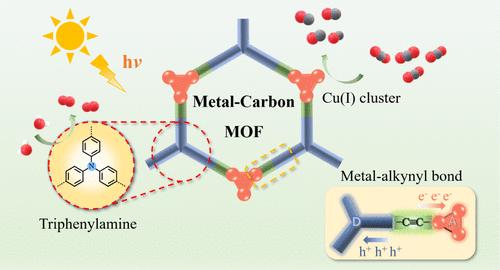Rational Design and Synthesis of a Metal–Organic Framework Featuring Cu(I)–Carbon Bonds for Enhanced Artificial Photosynthesis
IF 15.6
1区 化学
Q1 CHEMISTRY, MULTIDISCIPLINARY
引用次数: 0
Abstract
The development of a stable and highly efficient artificial photosynthetic system without the need for additional electron sacrificial agents has long been a pursuit but remains highly challenging. Here, we designed and synthesized a novel metal–organic framework (MOF), Cu-TEPA (TEPA = tris(4-ethynylphenyl)amine), by connecting triphenylamine and Cu(I) ions via metal–carbon (M–C) bonds for artificial photosynthesis. Cu-TEPA showed excellent stability in pH = 0 or 14 aqueous solutions for over 12 h. Interestingly, using water as the electron donor, Cu-TEPA demonstrated remarkable performance in the overall artificial photosynthetic reaction, achieving a CO yield of 86.0 μmol g–1 h–1 with nearly 100% selectivity and an O2 evolution rate of 43.9 μmol g–1 h–1, maintaining performance after five cycles. Mechanistic studies reveal that triphenylamine acts as both a photosensitizer and water oxidation catalyst, while Cu(I) reduces CO2 to CO. Therefore, the superior performance of Cu-TEPA can be attributed to the excellent photosensitivity of triphenylamine, the high catalytic activity of Cu(I), and the more stable and conductive M–C bonds between the organic ligands and metal ions.

基于Cu(I) -碳键的金属-有机骨架的合理设计与合成
长期以来,开发一种稳定而高效的人工光合系统,而不需要额外的电子牺牲剂,一直是人们追求的目标,但仍然具有很高的挑战性。本文设计并合成了一种新型的金属-有机框架(MOF), Cu-TEPA (TEPA = tris(4-乙基苯基)胺),通过金属-碳(M-C)键连接三苯胺和Cu(I)离子,用于人工光合作用。Cu-TEPA在pH = 0或14的水溶液中均表现出良好的稳定性,持续时间超过12 h。以水为电子供体,Cu-TEPA在整体人工光合反应中表现出优异的性能,CO产率为86.0 μmol g-1 h - 1,选择性接近100%,O2析出率为43.9 μmol g-1 h - 1,经过5个循环后仍保持良好的性能。机理研究表明,三苯胺同时具有光敏剂和水氧化催化剂的作用,而Cu(I)将CO2还原为CO。因此,Cu- tepa的优异性能可归因于三苯胺优异的光敏性、Cu(I)较高的催化活性以及有机配体与金属离子之间更稳定和导电的M-C键。
本文章由计算机程序翻译,如有差异,请以英文原文为准。
求助全文
约1分钟内获得全文
求助全文
来源期刊
CiteScore
24.40
自引率
6.00%
发文量
2398
审稿时长
1.6 months
期刊介绍:
The flagship journal of the American Chemical Society, known as the Journal of the American Chemical Society (JACS), has been a prestigious publication since its establishment in 1879. It holds a preeminent position in the field of chemistry and related interdisciplinary sciences. JACS is committed to disseminating cutting-edge research papers, covering a wide range of topics, and encompasses approximately 19,000 pages of Articles, Communications, and Perspectives annually. With a weekly publication frequency, JACS plays a vital role in advancing the field of chemistry by providing essential research.

 求助内容:
求助内容: 应助结果提醒方式:
应助结果提醒方式:


